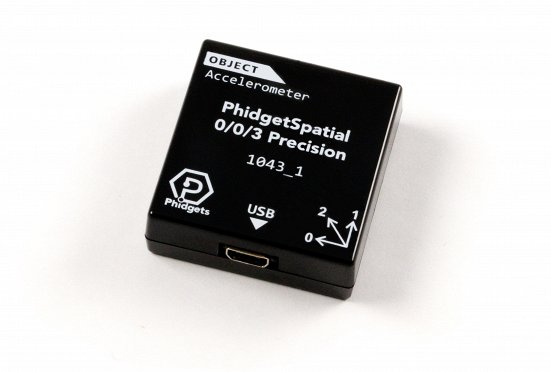Loading...
 PhidgetSpatial Precision 0/0/3 - P/N 1043_1B The Spatial 0/0/3 is a sensor family capable of measuring accelerations of ±8g on three axes. WD supports the Basic and the Precision model of the USB connected PhidgetSpatial 0/0/3, as well as the VINT connected Accelerometer Phidget.
Additionally, any Spatial 3/3/3 Phidget can be set up as a 0/0/3 device, it will then only return the acceleration values.
Note that all Phidget devices are only available in the licensed Widget Designer edition, not the Free version.
|
To add a Phidgets Spatial 0/0/3 device, open the Devices menu and select Phidgets Device > Spatial 0/0/3 Device. This will open the Configuration dialog. Alternatively, you can add a new device in the Configuration dialog with the "+" button when the dialog is already open.
On the right side, you can name, dis-/enable the device or configure it as explained in the next paragraph.
The Type informs you about the type of device or connection. The Groups lists the groups to which this device belongs. The Name is the unique identifier for this Phidgets Spatial 0/0/3 object in WD and the general rules for naming objects apply here as well: only letters, numbers and underscores are allowed; the first symbol must be a letter. It is possible to change the default name to a more descriptive one. When scripting, enter this Name to access available members or use the Project object and device Type instead; examples are shown further down.
The Id offers an alternative way to address the device when scripting.
The "Enable" check box is ticked per default. On the left side, you should see that the icon in front of your Phidgets Spatial 0/0/3 is a filled blue circle. An empty blue circle indicates an enabled device which is not connected. A filled gray circle indicates a disabled device.
You can close the dialog at any time. The newly created device will also be added to the Devices menu > Phidgets Device > Phidgets Spatial 0/0/3 Device and can be opened from here or with Devices menu > Configuration.
Fill out Hub Port, Channel and Is Hub Port Device according to the Phidget Addressing Information dialog. After the connection is established, the Value and Acceleration fields will update as soon as a change is registered. |
After adding a Phidgets Spatial 0/0/3 device, it can also be scripted which allows to perform actions on the device as well as retrieve information from it.
To send commands to the device, create a CustomScript button or anything with a scripting field. Enter the device's identifier name into the script field (per default that is e.g. "Phidgets_Spatial_0_0_3_1") and Script Assist will offer a list of all available members.
You can for example enable the device using scripting:
Phidgets__Spatial_0_0_3_1.Enable
You can also read out the minimum acceleration value (in g) which triggers a response of the device:
vint = Phidgets_Spatial_0_0_3_1.MinAccelerationChangeTrigger
The scripting structure for Phidgets provides two different approaches for setting and retrieving values.
If you are already familiar with the object-based notation and using properties, all device properties can be used like any other object property you have already encountered:
Label5.Text = "Current X acceleration: " + Phidgets_Spatial_0_0_3_1.XAxis + "g"
If you prefer a command structure that distinctly implies the action to be performed, you can use the "Set..." and "Get..." members:
Label5.Text = "Current X acceleration: " + Phidgets_Spatial_0_0_3_1.GetXAxis + "g"
Both approaches can be used interchangeably.
Please keep in mind that some properties are read-only properties, e.g. the measured acceleration values for the three axes, and do not provide a "Set..." member.
Furthermore, the higher-level properties of the device itself, like the Enabled state, need to be scripted as properties and do not provide the "Set..." and "Get..." members.
For a list with all available members and commands with examples and descriptions, please refer to the chapter Phidgets Spatial 0/0/3 Members.
As an alternative to explicitly naming the device, the "Project" object can be used. Choose the device type and address the device by entering its ID or name. Script Assist then offers you the same list of members. This is the alternative for the first example from above:
Project.Phidgets_Spatial_0_0_3(1).Enable
Substituting the ID with a dynamic variable allows automation. Actions can be performed on many connections of the same type simultaneously, e.g. by using for-loops:
For i = 1 to 10 {
Project.Phidgets_Spatial_0_0_3(i).Enable
}
The chapter "Project and Context Member" shows more examples with for-loops and if-clauses; of course, normal variables can also be used.
Event Listeners can be added in the Configuration dialog and provide a simple way of listening to triggers from connected devices.
Please see the chapter Event Listener and Group Event Listener for a detailed description of its functionality and the Phidgets Spatial 0/0/3 Events chapter for a list (with examples and description) of the possible events raised by this device type.
After creating a Phidgets Spatial 0/0/3 device, you can also use it in the node system as an input node to retrieve acceleration information.
Please see the chapter "Phidgets Spatial 0/0/3 Input" for more information about the node itself or the chapter "Tutorial: Nodes" for information about the node system.